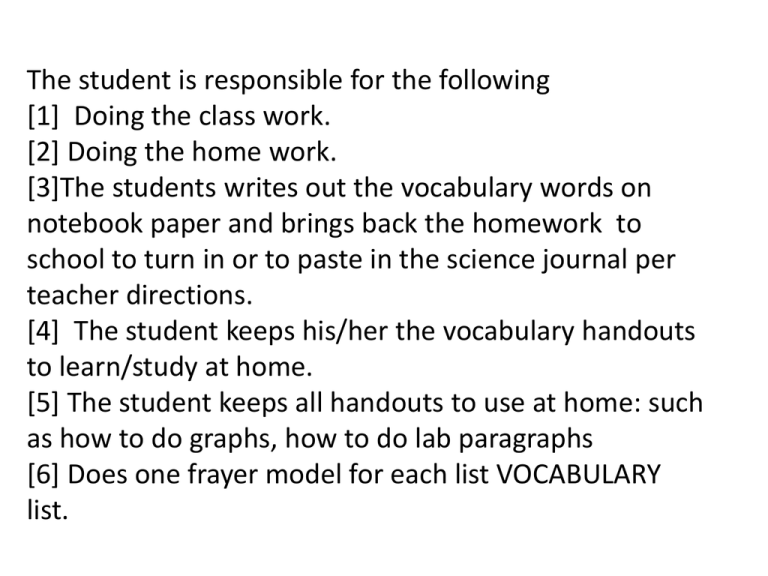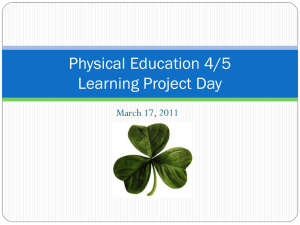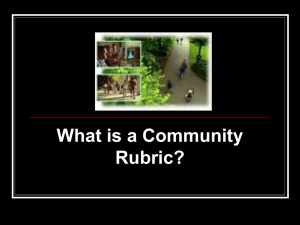Mrs. Whites_Helpful directions for homework and classwork
advertisement

The student is responsible for the following [1] Doing the class work. [2] Doing the home work. [3]The students writes out the vocabulary words on notebook paper and brings back the homework to school to turn in or to paste in the science journal per teacher directions. [4] The student keeps his/her the vocabulary handouts to learn/study at home. [5] The student keeps all handouts to use at home: such as how to do graphs, how to do lab paragraphs [6] Does one frayer model for each list VOCABULARY list. On the next slide is the frayer model rubric given out in class Definition RUBRIC 15 POINTS Examples RUBRIC 15 POINTS CREATIVITY RUBRIC 15 POINTS NEATNESS RUBRIC 10 POINTS Word or Phrase RUBRIC 15 POINTS FYI: MINUS 25% IF THE 5 RECTANGLES ARE WITHOUT COLOR Meaningful Sentence RUBRIC 15 POINTS Picture RUBRIC 15 POINTS First last name, period [#] On the next slide is an example of how to do a frayer model with the word “pet.” Pet is not one of the vocabulary words. my curled up sleeping cat my stretching awake cat Examples: Definition a domesticated animal kept for companionship or amusement Pet Word or Phrase Meaningful Sentence The pet owner believes his dog is a good guard dog. How could you test this statement? Picture: my sleeping dog This is an example of how to do a graph from a RUBRIC. The rubric is printed on the example 6.1.1 Essential Vocabulary: inquiry – a formal investigation to determine facts investigation – examination or inquiry into a problem or scientific question theory – an idea or belief about something arrived at through speculation, investigations, and observations nature of science - consists of the collection of data through observation and experimentation, and the formulation and testing of hypotheses hazard -a source of danger recycle - to treat or process so as to make suitable for reuse resource - a source of supply that can be readily drawn upon when needed disposal -getting rid of something toxic - a poisonous substance safety - being reasonably free of danger irritant - a substance that can produce inflammation, pain or soreness on body flammable - will catch fire easily equipment - anything provided for a specific purpose 6.1.2. vocabulary 1. International System of Units - an internationally accepted coherent system of physical units, derived from the MKSA system, using the meter, kilogram, second, ampere, kelvin, mole, and candela as the basic units (SI units) of the fundamental quantities length, mass, time, electric current, temperature, amount of substance, and luminous intensity 2. data - individual facts, statistics, or items of information 3. hypothesis - an educated guess 4. observation - an act or instance of viewing or noting a fact or occurrence for some scientific or other special purpose 5. model - a representation, generally in miniature, to show the construction or appearance of something 6. table - an arrangement of words, numbers, or signs, or combinations of them, as in parallel columns, to exhibit a set of facts or relations in a definite, compact, and comprehensive form; 7. graph - a diagram representing a system of connections or interrelations among two or more things by a number of distinctive dots, lines, bars, etc 8. explanation - a statement made to clarify something, including data and observations, and make it understandable 9. conclusion - a reasoned deduction or inference 10. inference - using clues from the text and your own knowledge and experience to draw a conclusion 11. dependent variable - is what changes when the independent variable changes; depends on the outcome of the independent variable 12. independent variable - is what you, the experimenter, changes in order to do your experiment 13. constant - unchanged through time or space; permanent 14. variable - changeable 15. claim – a conclusion that answers a question 16. evidence – data that supports a claim 17. reasoning – argument that links the claim and evidence and shows why the data supports the claim 18. research – scientific study 19. scientific explanation - to provide an account of how and why scientific inquiry is carried out 6.1.2 6.1.3. Essential Vocabulary: 1. 2. 3. 4. 5. 6. 7. 8. reference point - non-moving object position -the point or area occupied by something direction - the line or course along which something moves, lies, or points distance - the space or amount of space between two points, lines, surfaces, or objects time - a moment, hour, day, or year as indicated by a clock or calendar speed - distance traveled divided by the time needed to travel that distance force -an influence (as push or pull) that tends to produce a change in speed or direction of motion of something motion - an act or process of changing place or position Lab paragraphs are homework after each lab. The following is the rubric • • • • • 20 pts big/[a.k.a. overarching] question 20 pts hypothesis 20 pts testable question 10 pts procedures [a.k.a. “This is what we did:…”] 50 pts independent variable, dependent variable, control variables, data analysis from the chart of data and the graph, conclusion • possible errors a.k.a. “ Next time I would do the lab differently. I would …” Journal rubric: 5, 4, 3, 2, 1 & 0 Journals are graded twice during the six-weeks. • • • • 5 wow product 4 all done as expected 3 almost all done – missing 1 or 2 things 2 sort of what expected – missing 3-4 things, sort of organized, little creativity on illustrations • 1 2 or more parts missing, very poorly organized or very poorly illustrated • 0 does meet standards 6.1.4. Essential Vocabulary 1. 2. 3. 4. 5. 6. 7. 8. 9. 10. 11. 12. 13. 14. • reference point - non-moving object position -the point or area occupied by something direction - the line or course along which something moves, lies, or points distance - the space or amount of space between two points, lines, surfaces, or objects time - a moment, hour, day, or year as indicated by a clock or calendar speed - distance traveled divided by the time needed to travel that distance force -an influence (as push or pull) that tends to produce a change in speed or direction of motion of something motion - an act or process of changing place or position energy - the ability to make something happen Newton - unit of the measurement of force work- the transfer of energy from one object to another, especially in order to make the second object move in a certain direction; equal to the amount of force multiplied by the distance over which it is applied tools - equipment used in a profession inclined plane - a plane surface that makes an oblique angle with the plane of the horizon pulley - small wheel with a grooved rim and runs used singly with a rope or chain to change the direction of a pulling force and in various combinations to increase the applied force especially for lifting weights 6.2.1. Essential Vocabulary: 1. 2. energy- the ability to do work or cause change law of conservation of energy- states that matter can never be created or destroyed it just changes from one form to another 3. energy transformation- energy changing from one form to another 4. chemical energy- stored in matter because of its chemical make up example: food 5. thermal energy- energy that all objects have; increases as their temperature increases 6. radiant energy- energy of light 7. mechanical energy- energy that matter has because of its position 8. electrical energy- energy carried by electric current that comes out of batteries and wall sockets, is generated at large power plants, and is readily transformed into other types of energy 9. nuclear energy- energy stored in atomic nuclei that can be transformed into other forms of energy by complex power plants 10. potential - energy stored in an object due to its position 11. kinetic - energy an object has due to its motion







